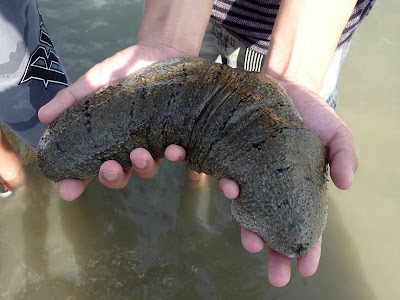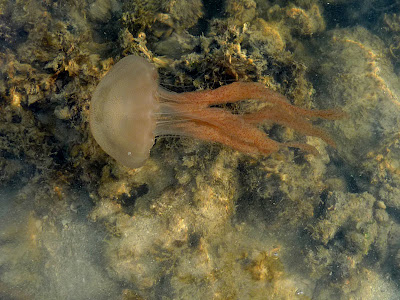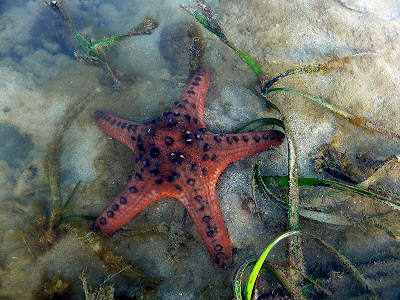Had another busy week with lots of workshops that I couldn't find time to blog again...
Anyway, I was the hunter-seeker on Saturday and the guide for a group of enthusiastic students from Tampines Secondary on Sunday. Here's another quick look at some of the shots I managed to grab for the 2 walks.
We had to walk to the intertidal area again since it was rather early and the NEA staff hasn't arrived to drive us to there. This was my group from Tampines Secondary School. They were certainly a very jolly bunch of people, and even the long walk to the shore was made rather enjoyable :P
And here's the usual group photo I always got my groups to take while crossing the seagrass lagoon.
As per always, our visitors got all excited when they saw the sand-sifting sea stars (Archaster typicus).
I found 2 really long synaptid sea cucumbers (Family Synaptidae) on Saturday, and 3 of them on Sunday. The longest one was more than 2m long!
Another common sea cucumber found on Semakau - the stonefish sea cucumber (Actinopyga lecanora).
This sea cucumber, commonly called the sandfish sea cucumber (Holothuria scabra), is the species that's eaten by the Chinese. However, they must be processed to remove the toxins before they can be eaten.
Here's another sea cucumber which I often saw on our southern shores, but still don't know its ID. When we touch it gently, it immediately eject lots of sticky white threads to defend itself. When they encounter any predators, the sticky threads will stick to and confuse the latter. Update: Have found out that this is could be an impatient sea cucumber (Holothuria impatiens). 2nd Upate: Apologies for the confusion. This is not Holothuria impatiens. But a different species. More details to be published soon when we confirmed the ID.
A smooth and pretty ovum cowrie (Cypraea ovum) hiding among some rocks.
We found a cute upside-down jellyfish (Cassiopea sp.). This jellyfish has symbiotic algae, mostly in its tentacles, which photosynthesises better with it being upside-down since they will then be exposed to the sun. Some of the food made by the algae will be transferred to the jellyfish.
These pinkish orange jellyfish seemed to be in season too, and we had been seeing lots of them in local waters recently. Understand from CH that they sting very painfully if you accidentally touch them.
I found this interesting sea anemone on the leaf of a tape seagrass. The last time I found something similar was last October at Changi. According to sea anemone expert Dr Daphne at that time, this anemone is a member of the family Aliciidae, and these anemones supposedly can give anyone who touches them a nasty sting.
Not sure if it's just my imagination or what, but I do get the feeling that I'm seeing more such soft corals these days.
The highlight of any Semakau trips was always the knobbly sea star (Protoreaster nodosus).
And we found two of them on Saturday!
Here's the traditional group shot with the knobbly sea star.
And surprise surprise! On Saturday, I found a cushion star (Culcita novaeguineae). The last time we found one at Semakau was in March 2007! This cute sea star supposedly feed on corals though :P
All the students from Tampines Secondary School who joined the walk on Sunday managed to squeeze into the shelter at the southern most point of Semakau for a group shot.
While it was a really hot and sunny weekend, I was glad that everyone still managed to have a lot of fun! :)
Saturday, May 31, 2008
Semakau Walks Over Last Weekend
Saturday, May 24, 2008
Nature Workshop with Dunman High
I conducted a nature workshop recently for some Dunman High students, and here's a quick account of the experience we shared.
On the first day, I brought them to Pulau Ubin, and gave them a guided walk along the Sensory Trail and also Chek Jawa Boardwalk. Unfortunately, I forgot to bring my camera that day, and thus have no photos to share here.
On the second day, we went to Tuas grassland in the morning.
It was something new for most of the students, I guess. Everybody's feet had to get wet as Tuas is usually water-logged.
Many pretty plants and animals live in Tuas, including the ground orchid in the photo and the little crab spider partially hidden.
Tuas grassland is also where you'll find Singapore's smallest dragonfly - the pygmy dragon.
Once everyone got into water, we decided to have a group photo.
And here's a more energetic-looking one... :P
Here's another group photo taken among the complex network of sea morning glory vines.
In the afternoon, we went to Bukit Timah Hill.
There are many long-tail macaques just near the entrance to the reserve.
But what got us really excited was this monitor lizard eating a huge centipede. The centipede was still alive and struggling when we saw the monitor lizard.
There were lots of cicadas making loud screeching sounds in the forest, and this time round, I managed to catch one to show the students their underside.
On the last day, we went Semakau Landfill.
We had to cross a seagrass lagoon to reach the reef area.
In the seagrass lagoon, I found this huge synaptid sea cucumber which is probably more than 2m long.
Yet anther sea cucumber we found was this stonefish sea cucumber.
There were lots of sand-sifting sea stars, some of them getting really to perform external fertilisation.
We really wonder what happen to this file snake. Its head was stuck in a hole.
Fortunately, we managed to find the knobbly sea star and took some quick group photos.
Soon, tide was rising and on heading back to the mangrove area, I spotted this little horseshoe crab.
On the whole, I have to say the students were great and we learned a lot of things from each other. Looking forward to see some of them joining as nature volunteers in future!
Friday, May 16, 2008
Semakau Landfill Trip with SBWR Staff & Guides on 10-11 May 2008
This is another very late post. Was very busy over the past 1 week and hardly had time to do any blogging :P
Anyway, we had an overnite trip at Semakau Landfill with a group of Sungei Buloh Wetland Reserve staff and volunteers last weekend. We had some free and easy time on Saturday afternoon followed by a BBQ, and on Sunday morning, we went to the intertidal area for a guided walk.
Here's a quick shot of the SBWR people on the bus on the way to the southern most tip of the island on Saturday.
Along the way, we saw this great-billed heron (Ardea sumatrana), which is said to be the tallest bird in Singapore.
When we went to the southern most point again in the evening for the BBQ, we spotted one of the resident blacktip reef shark (Carcharhinus melanopterus) in the phase 2 lagoon! The last time we saw one was like a year ago, and thus I was really happy!
The next morning on Sunday, we decided to walk to the intertidal area.
Along the way, there were lots of tawny coasters (Acraea terpiscore) on the wild flowers by the road side.
At the edge of the seagrass meadow, I found a dragonfish sea cucumber (Stichopus horrens).
I also found this huge nudibranch nearby, which was probably a Dendrodoris tuberculosa.
There were lots of sand sifting sea star (Archaster typicus)!
The resident gigantic carpet anemone (Stichodactyla gigantea) was fortunately still there. While there were no anemone fishes, I found a pair of anemone shrimps on it.
Found this noble volute (Cymbiola nobilis) wandering among some seagrass.
I've always like sunflower mushroom corals (Heliofungia actiniformis), even though they are so common on Semakau Landfill.
It was a rather hot day, and we only managed to find 1 sandfish sea cucumber (Holothuria scabra).
Fortunately, we still managed to find the knobbly sea star (Protoreaster nodosus). Must really apologise to CK that dunno why he couldn't find it on the left side that day, as we usually found them there. In fact, the one above was found on the left side as well...
The glossodoris nudibranchs (Glossodoris atromarginata) seemed to be in season, as we saw many of them.
The tide was a little high, but fortunately the water was clear enough for us to see the fluted giant clam (Tridacna squamosa).
I managed to find a nice little colony of staghorn corals (Acropora sp.) too.
And somehow, there seemed to be more flowery soft corals. Not sure if by chance I just didn't see them much for the past 2 years plus, or there were really more of them these days.
We found a few flatworms too!
But my personal best find for the day must be this ultra cute and well camouflaged frogfish (probably Lophiocharon trisignatus)!
Yet another great find by our other hunter-seekers was this pretty pipefish (Syngnathidae).
But the find which caused the most excitement must be these few ocellaris clownfish (Amphiprion ocellaris) trapped in a little tidal pool just next to their host anemone.
All in all, it's certainly a great weekend. Thanks to SBWR for preparing the BBQ! :P

















